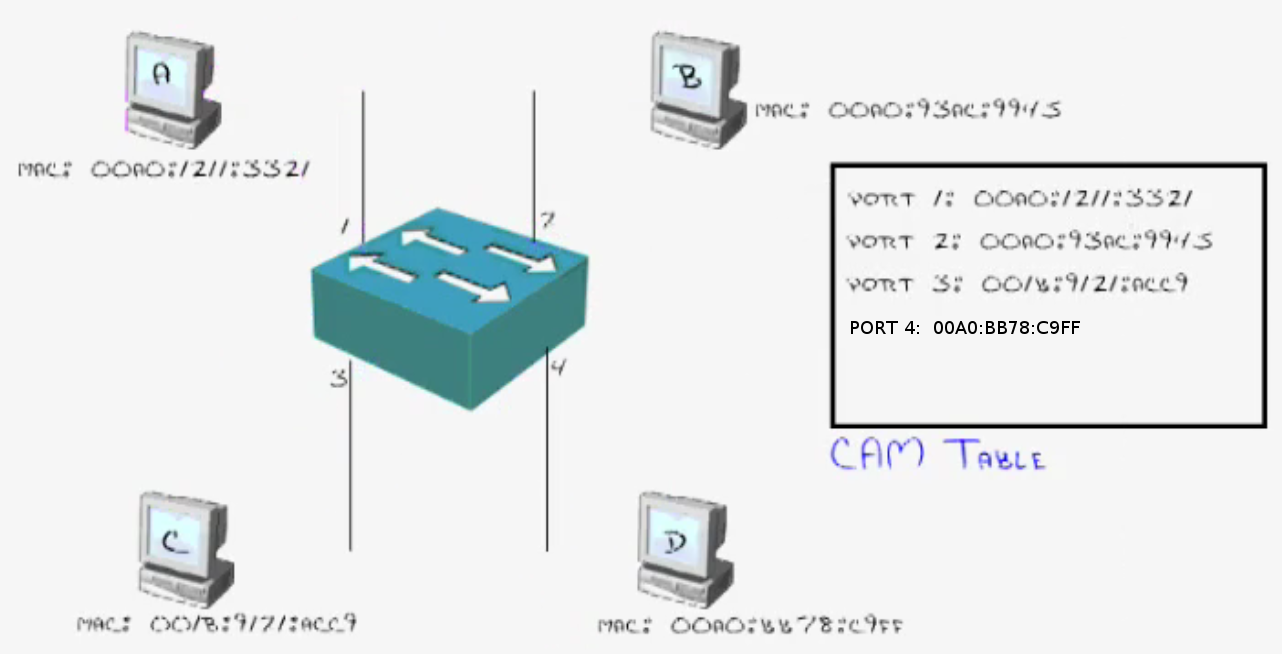The Problem with Shared CSMA/CD
Carrier Sense Multiple Access / Collision Detection
Hubs and Switches perform the same function, but are significantly different.
- Hubs send all incoming signals to all connected PCs.
- Hubs work at the Physical Layer, sees the signal and sends it out.
- Hub Speeds are very fast – Wire Speed.
- No difference between Unicast, Broadcast or Multicast
- 1 Collision Domain: Only one device can send at a single time
- 1 Broadcast Domain: One broadcast will travel through every Hub connected to it.
- The more PCs you connect, the more collisions you’ll get and transmissions rates slow significantly.
Understanding Collisions
- One of the colliding devices will send a “Jam Signal”
- It will halt all communication for a random amount of time (<1 second) before attempting to resend.
- After both devices have sent their data, the Jam is released and traffic can resume as normal.
Understanding Bridges
- Bridges connect between hubs and learn MAC addresses.
- By using a Bridge, you divide your network into 2 Collision Domains (or more, depending on # of ports on the bridge.)
- This allows both Collision Domains to sent amongst themselves without creating collisions.
- Bridges were popular between Mid ’80s to early 90’s
- Bridges were slow. MAC address learning done via software.
Understanding Switches
- Switches operate at the Data Link Layer because it “Sees” MAC addresses and can learn them.
- Each Switchport is a Collision Domain – All devices can Transmit at the same time!
- Allow Full Duplex Communications (Can Transmit and Receive Simultaneously.)
- MAC Learning done via ASIC chip (Application Specific Integrated Circuit) so very fast!
- Switches are as fast as Hubs – Wire Speed!
Understanding Collision Domains and Broadcast Domains
Collision Domain: How many devices can send or receive at the same time.
Broadcast Domain: How far a signal can travel before it stops.
How a Switch…Switches!
- Switches ONLY Learn a MAC Address when that connection Transmits
- If PC-A sends an ARP, looking for PC-B:
- It sends its MAC as the Source MAC
- It sends FFFF:FFFF:FFFF as the Destination MAC
- This designates that ALL recipents should LISTEN to the Packet!
- The Switch receives the ARP and learns the location of PC-A
- The Switchport and MAC are then stored in the CAM Table (Content Addressable Memory)
- When PC-B receives the ARP, it replies with its MAC, which is then stored.
- It takes a Switch <15 Seconds to learn all MAC addresses connected to it.
If a Switch DOES NOT KNOW a MAC Address:
- Assume PC-A already knows the MAC address of PC-C, it will encode both the Source MAC and Destination MAC in the Packet.
- The Switch receives the Packet and not knowing which Switchport owns the Destination MAC, so it sends to ALL Switchports (Except the Sending) with FFFF:FFFF:FFFF (Broadcast)
- Only the correct owner of the IP address embedded as the Destination Address will respond and in doing so will send the correct MAC for the Switch to learn.

